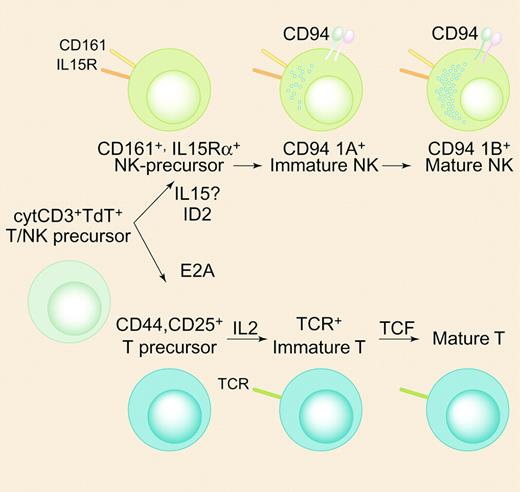Comment on Lin et al, page 3567
Lin and colleagues report that patients with lymphoblastic lymphomas (LBLs) expressing CD94 1A transcripts had a better prognosis than patients with LBLs lacking CD94 1A transcript expression.
CD94 gene expression is regulated by distal and proximal promoters that transcribe unique initial exons specific to each promoter.1,2 These exons do not affect the coding sequence of the CD94 protein. The proximal promoter (CD94 1B transcript) is constitutively active; while the distal promoter (CD94 1A transcript) is induced only after activation with interleukin 2 (IL-2) and/or interleukin 15 (IL-15).1 In this issue of Blood, Lin and colleagues show that CD94 transcript expression can be used to distinguish lymphoblastic lymphomas (LBLs) as having been derived from immature natural killer (NK) versus T cells, and that differential CD94 transcript expression may characterize early NK-cell development.
The majority of the human natural killer (NK) cells develops from hematopoietic stem cells (HSCs) in the adult bone marrow, but a fraction also descends from lymph node HSCs and from early precursors in the thymus. In the currently accepted paradigm of NK-cell ontogeny, there is a first phase, in which HSCs require stem-cell factor (SCF) and Flt3 ligand to commit to the NK-cell lineage, followed by a second phase, in which the NK progenitors under the influence of cytokines, principally IL-15, differentiate and mature into functional NK cells.3 In addition, several transcription factors, including members of the zinc finger, external transcribed spacer (ETS), and interferon regulatory factor families, are also involved, at different stages, in the development and generation of mature NK cells.
Major histocompatibility complex (MHC) class I–specific receptors appear during the final steps of NK-cell maturation. Of these receptors, CD94/NKG2 receptors that recognize histocompatibility leukocyte antigen E (HLA-E) are expressed earlier and at a greater frequency than killer immunoglobulin-like receptors (KIRs).4 Virtually all human NK cells express CD94. In recent years, significant progress has been made in the elucidation of the mechanisms controlling transcription of the CD94 gene.1,2 The work of Lin and colleagues sheds some light on the use of the two different CD94 promoters, if not why the regulation of the CD94 gene requires two promoters. The authors demonstrated that expression of the CD94 1A transcripts characterized thymic NK precursors that express the α chain of the IL-15 receptor (IL-15Rα), while in peripheral tissues CD94 1B transcripts are more prevalent. This pattern of expression indicates that the regulation of CD94 expression is developmental stage specific (Figure 1), perhaps involving different sets of transcription factors or complexes.FIG1
A 3-stage model of NK development. The cytoplasmic CD3+ nuclear TdT+ bipotent T/NK-cell precursor may develop into either immature T cells under the actions of E2A and IL-2 or immature NK cells under the actions of ID2 and IL-15. Lineage commitment is fully established when immature NK cells express CD94 1A transcripts. The model shows the expression of the CD94 receptor on immature NK cells, but it is unclear whether it is expressed on the surface at this stage of development. Illustration by Paulette Dennis.
A 3-stage model of NK development. The cytoplasmic CD3+ nuclear TdT+ bipotent T/NK-cell precursor may develop into either immature T cells under the actions of E2A and IL-2 or immature NK cells under the actions of ID2 and IL-15. Lineage commitment is fully established when immature NK cells express CD94 1A transcripts. The model shows the expression of the CD94 receptor on immature NK cells, but it is unclear whether it is expressed on the surface at this stage of development. Illustration by Paulette Dennis.
The investigators studied the expression of CD94 1A and 1B transcripts in extranodal nasal-type NK/T-cell lymphoma (ENNLs) and LBLs from lymph nodes and mediastinal biopsies in order to determine if CD94 transcript expression was NK LBL specific. T-cell markers (intracytoplasmic CD3 and terminal deoxynucleotidyl transferase [TdT]) or NK markers (CD161 and KIR) can be expressed in LBLs from both lineages. Lin and colleagues were able to distinguish two groups of LBLs: one group that expressed CD94 1A and was classified as originating from immature NK cells, and a second group that was CD94 1A– and predominately of T-cell origin. Though classification of LBLs into NK- and T-cell origin based on the expression of CD94 1A is not perfect because of the possibility of CD94 1A (and 1B) expression by T cells, the expression of CD94 1A appears to have important clinical consequences. Remarkably, patients with CD94 1A+ LBLs had a 100% survival rate at 2 years versus 27% for patients who were CD94 1A–.
These results provide valuable refinement of the LBL classification and raise the question as to whether CD94 1A expression has direct bearing on LBL disease progression. Future studies by Lin et al's laboratory and other groups should help explain what mechanisms, transcription factors, and/or environmental factors are involved in the switch from one CD94 promoter to the other. Better models of NK-cell development have to be established to understand CD94 gene transcription and conclusively assign CD94 1A transcripts to immature NK cells and CD941B transcripts to more mature NK cells. ▪


This feature is available to Subscribers Only
Sign In or Create an Account Close Modal